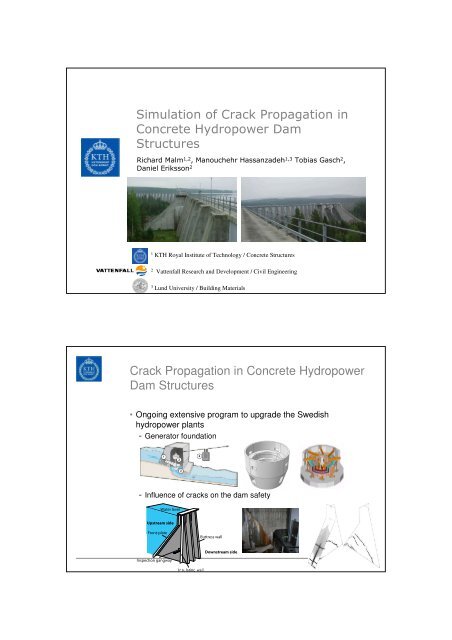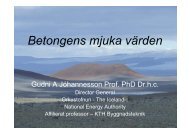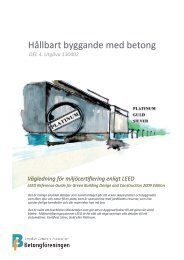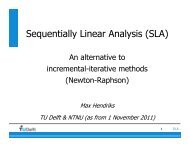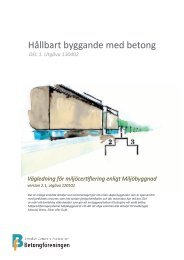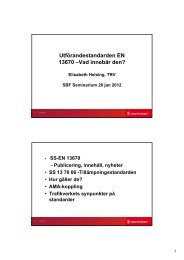Simulation of Crack Propagation in Concrete Hydropower Dam ...
Simulation of Crack Propagation in Concrete Hydropower Dam ...
Simulation of Crack Propagation in Concrete Hydropower Dam ...
Create successful ePaper yourself
Turn your PDF publications into a flip-book with our unique Google optimized e-Paper software.
<strong>Simulation</strong> <strong>of</strong> <strong>Crack</strong> <strong>Propagation</strong> <strong>in</strong><strong>Concrete</strong> <strong>Hydropower</strong> <strong>Dam</strong>StructuresRichard Malm 1,2 , Manouchehr Hassanzadeh 1,3 Tobias Gasch 2 ,Daniel Eriksson 21 KTH Royal Institute <strong>of</strong> Technology / <strong>Concrete</strong> Structures2 Vattenfall Research and Development / Civil Eng<strong>in</strong>eer<strong>in</strong>g3 Lund University / Build<strong>in</strong>g Materials<strong>Crack</strong> <strong>Propagation</strong> <strong>in</strong> <strong>Concrete</strong> <strong>Hydropower</strong><strong>Dam</strong> Structures• Ongo<strong>in</strong>g extensive program to upgrade the Swedishhydropower plants- Generator foundation- Influence <strong>of</strong> cracks on the dam safetyWater levelUpstream sideFront-plateButtress wallDownstream sideInspection gangwayInsulat<strong>in</strong>g wall
2.5 mStorf<strong>in</strong>nforsen hydropower dam• Storf<strong>in</strong>nforsen concrete buttress dam- Total length <strong>of</strong> 1200 m (800 m concrete)- 100 concrete monoliths• Several different types <strong>of</strong> cracks found <strong>in</strong>-situWater levelUpstream sideFront-plateButtress wallDownstream sideInspection gangwayInsulat<strong>in</strong>g wallNumerical simulations• One monolith is modeled with 3D shell elements- Re<strong>in</strong>forced concrete• Nonl<strong>in</strong>ear material model CDP (<strong>Concrete</strong> <strong>Dam</strong>agedPlasticity) <strong>in</strong> ABAQUS v 6.10• Thermal analyses- W<strong>in</strong>ter air temperature – 15 °C- Summer air temperature +25 °C• <strong>Simulation</strong> steps- Static loads (gravity, water pressure)- Cycle w<strong>in</strong>ter and summer temperatures for the <strong>in</strong>itialdesign <strong>of</strong> the monolith- Cycle w<strong>in</strong>ter and summer temperatures after the<strong>in</strong>sulat<strong>in</strong>g wall was <strong>in</strong>stalledc150 mmTwo layers <strong>of</strong>rebars φ19 mmEach 50 mmbelow theconcretesurfacec400 mmc400 mmc400 mmc400 mmc300 mmc400 mm
Steady State Thermal Calculations• Cyclic steady state thermal calculations were performed- Summer – w<strong>in</strong>ter (without an <strong>in</strong>sulat<strong>in</strong>g wall)- Summer – w<strong>in</strong>ter (with an <strong>in</strong>sulat<strong>in</strong>g wall)• Coupled thermo-stress analysis- Import<strong>in</strong>g the steady state temperatures <strong>in</strong>to a model thatcalculate result<strong>in</strong>g stresses and predict crack<strong>in</strong>gW<strong>in</strong>ter conditionsSummer conditions<strong>Simulation</strong> - Seasonal temperature variationBefore the <strong>in</strong>sulat<strong>in</strong>g wallIncl<strong>in</strong>ed cracks <strong>in</strong> the buttressHorizontal cracks <strong>in</strong> the front-plateAfter the <strong>in</strong>sulat<strong>in</strong>g wallIncl<strong>in</strong>ed crack <strong>in</strong> the buttress
Animation <strong>of</strong> the crack propagationCyclic seasonal temperature variation (summer/w<strong>in</strong>ter)Deformation scale factor 400Probabilistic analyses• Study the <strong>in</strong>fluence <strong>of</strong> material properties and materialdistribution on the crack trajectory- Starts from an analysis where the <strong>in</strong>cl<strong>in</strong>ed crack is <strong>in</strong>itiatedand simulate further crack propagation• Monte Carlo <strong>Simulation</strong> - 1000 analyses- Sub-model <strong>of</strong> the area <strong>of</strong> <strong>in</strong>terest with a significantly ref<strong>in</strong>edmeshSub-model
Stochastic material propertiesProbability• Generated 1000 random material properties with log-normaldistribution0.250.200.150.100.05Statistics <strong>of</strong> randomgenerated propertiesN = 1000µ = 2.53 MPaσ = 0.78 MPaCOV = 0.3100 1 2 3 4 5 6 7Tensile strength (MPa)Probability0.200.180.160.140.120.100.080.060.040.02Statistics <strong>of</strong> randomgenerated propertiesN = 1000µ = 120.9 Nm/m22σ = 35.8 Nm/mCOV = 0.30050 100 150 200 250 3002Fracture energy (Nm/m )010 15 20 25 30 35 40 45Elastic modulus (GPa)• Assum<strong>in</strong>g a high correlation between the material properties,above 95%88300Probability0.200.180.160.140.120.100.080.060.040.02Statistics <strong>of</strong> randomgenerated propertiesN = 1000µ = 25.2 GPaσ = 3.8 GPaCOV = 0.15Tensile strength (MPa)642Tensile strength (MPa)642Fracture energy (nm/m 2 )250200150100050 100 150 200 250 300Fracture energy (Nm/m 2 )010 20 30 40 50Elastic modulus (MPa)5010 20 30 40 50Elastic modulus (MPa)Material distribution• Randomly assign<strong>in</strong>g a set <strong>of</strong> material properties (f t , E c , G f ) foreach element <strong>in</strong> the sub-model and simulat<strong>in</strong>g the crackpropagationTensile Strength [MPa]Regions With Low Tensile Strength [MPa]Max6542.532Mean f t= 2.54 MPa1M<strong>in</strong>
Area subjected to crack<strong>in</strong>g• Based on all simulations- All cracked elements summarized <strong>in</strong> one plot- Calculated probability <strong>of</strong> crack<strong>in</strong>g<strong>Crack</strong> PatternCalculated probability <strong>of</strong> crack<strong>in</strong>g0.50.450.40.350.30.250.20.15<strong>Crack</strong>ed element fromthe all simulations<strong>Crack</strong>ed element <strong>in</strong> the orig<strong>in</strong>alanalysis (with mean values)0.10.05Conclusions• Several, more or less cracked dams <strong>in</strong> Sweden.- In many cases due to the new pattern <strong>of</strong> generator operation- Extensive ongo<strong>in</strong>g program to upgrade the dams• In this project, the non-l<strong>in</strong>ear f<strong>in</strong>ite element method have beenused to- Expla<strong>in</strong> the cause <strong>of</strong> cracks <strong>in</strong> a concrete buttress dam- Study the <strong>in</strong>fluence <strong>of</strong> distribution <strong>in</strong> material properties on thecrack trajectory- Prelim<strong>in</strong>ary results shows a difference <strong>in</strong> crack trajectory obta<strong>in</strong>edfrom a determ<strong>in</strong>istic analysis with mean values compared to themost probable crack trajectory obta<strong>in</strong>ed from probabilisticanalyses
Thanks for your attention!Richard Malm, PhDKTH Royal Institute <strong>of</strong> Technology<strong>Concrete</strong> Structures (malm@byv.kth.se)Vattenfall Research and DevelopmentCivil Eng<strong>in</strong>eer<strong>in</strong>g (richard.malm2@vattenfall.com)


